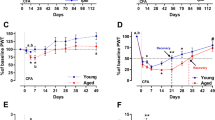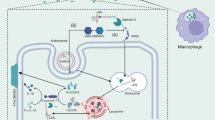Abstract
Objective
This study aimed to determine whether lipopolysaccharide (LPS) induces the loss of corneal nerve fibers in cultured trigeminal ganglion (TG) cells, and the underlying mechanism of LPS-induced TG neurite damage.
Methods
TG neurons were isolated from C57BL/6 mice, and the cell viability and purity were maintained for up to 7 days. Then, they were treated with LPS (1 µg/mL) or the autophagy regulator (autophibib and rapamycin) alone or in combination for 48 h, and the length of neurites in TG cells was examined by the immunofluorescence staining of the neuron-specific protein β3-tubulin. Afterwards, the molecular mechanisms by which LPS induces TG neuron damage were explored.
Results
The immunofluorescence staining revealed that the average length of neurites in TG cells significantly decreased after LPS treatment. Importantly, LPS induced the impairment of autophagic flux in TG cells, which was evidenced by the increase in the accumulation of LC3 and p62 proteins. The pharmacological inhibition of autophagy by autophinib dramatically reduced the length of TG neurites. However, the rapamycin-induced activation of autophagy significantly lessened the effect of LPS on the degeneration of TG neurites.
Conclusion
LPS-induced autophagy inhibition contributes to the loss of TG neurites.
Similar content being viewed by others
References
Fakih D, Zhao Z, Nicolle P, et al. Chronic dry eye induced corneal hypersensitivity, neuroinflammatory responses, and synaptic plasticity in the mouse trigeminal brainstem. J Neuroinflammation, 2019,16(1):268
Kishimoto Y, Yabuta C, Shearer TR, et al. FK962 promotes neurite elongation and regeneration of cultured rat trigeminal ganglion cells: possible involvement of GDNF. Invest Ophthalmol Vis Sci, 2012,53(9):5312–5319
Ohara K, Shimizu K, Matsuura S, et al. Toll-like receptor 4 signaling in trigeminal ganglion neurons contributes tongue-referred pain associated with tooth pulp inflammation. J Neuroinflammation, 2013,10:139
Kunda PE, Cavicchia JC, Acosta CG. Lipopolysaccharides and trophic factors regulate the LPS receptor complex in nodose and trigeminal neurons. Neuroscience, 2014,280:60–72
Chung MK, Lee J, Duraes G, et al. Lipopolysaccharide-induced pulpitis up-regulates TRPV1 in trigeminal ganglia. J Dent Res, 2011,90(9):1103–1107
Qin Y, Qiu J, Wang P, et al. Impaired autophagy in microglia aggravates dopaminergic neurodegeneration by regulating NLRP3 inflammasome activation in experimental models of Parkinson’s disease. Brain Behav Immun, 2021,91:324–338
Guo F, Liu X, Cai H, et al. Autophagy in neuro-degenerative diseases: pathogenesis and therapy. Brain Pathol, 2018,28(1):3–13
Hu J, Huang Y, Lin Y, et al. Protective effect inhibiting the expression of miR-181a on the diabetic corneal nerve in a mouse model. Exp Eye Res, 2020,192:107925
Lee JW, Nam H, Kim LE, et al. TLR4 (toll-like receptor 4) activation suppresses autophagy through inhibition of FOXO3 and impairs phagocytic capacity of microglia. Autophagy, 2019,15(5):753–770
Clarke JP, Mearow K. Autophagy inhibition in endogenous and nutrient-deprived conditions reduces dorsal root ganglia neuron survival and neurite growth in vitro. J Neurosci Res, 2016,94(7):653–670
Cho H, Jeon HJ, Park S, et al. Neurite growth of trigeminal ganglion neurons in vitro with near-infrared light irradiation. J Photochem Photobiol B, 2020,210:111959
Zhu Y, Liu Z, Peng YP, et al. Interleukin-10 inhibits neuroinflammation-mediated apoptosis of ventral mesencephalic neurons via JAK-STAT3 pathway. Int Immunopharmacol, 2017,50:353–360
Park T, Chen H, Kevala K, et al. N-Docosahexaenoy-lethanolamine ameliorates LPS-induced neuroinflammation via cAMP/PKA-dependent signaling. J Neuroinflammation, 2016,13(1):284
Lynds R, Lyu C, Lyu GW, et al. Neuronal plasticity of trigeminal ganglia in mice following nerve injury. J Pain Res, 2017,10:349–357
Li M, Xin M, Song K, et al. Evaluation of polyvinyl caprolactam-polyvinyl acetate-polyethylene glycol graft copolymer nanomicelle for trigeminal ganglion neurons delivering with intranasal administration. Curr Eye Res, 2018,43(3):406–414
Cortina MS, He J, Russ T, et al. Neuroprotectin D1 restores corneal nerve integrity and function after damage from experimental surgery. Invest Ophthalmol Vis Sci, 2013,54(6):4109–4116
Nakajima E, Walkup RD, Shearer TR, et al. FK962 induces neurite outgrowth in cultured monkey trigeminal ganglion cells. Graefes Arch Clin Exp Ophthalmol, 2017,255(1):107–112
Kaewpitak A, Bauer CS, Seward EP, et al. Porphyromonas gingivalis lipopolysaccharide rapidly activates trigeminal sensory neurons and may contribute to pulpal pain. Int Endod J, 2020, 53(6):846–858
Iannotta M, Belardo C, Trotta MC, et al. N-palmitoyl-D-glucosamine, a Natural Monosaccharide-Based Glycolipid, Inhibits TLR4 and Prevents LPS-Induced Inflammation and Neuropathic Pain in Mice. Int J Mol Sci, 2021,22(3):1491
Hartmann H, Hoehne K, Rist E, et al. miR-124 disinhibits neurite outgrowth in an inflammatory environment. Cell Tissue Res, 2015,362(1):9–20
Inada T, Sato H, Hayashi Y, et al. Rapamycin Accelerates Axon Regeneration Through Schwann Cell-mediated Autophagy Following Inferior Alveolar Nerve Transection in Rats. Neuroscience, 2021,468:43–52
Yang Y, Fukui K, Koike T, et al. Induction of autophagy in neurite degeneration of mouse superior cervical ganglion neurons. Eur J Neurosci, 2007,26(10):2979–2988
Yang Y, Coleman M, Zhang L, et al. Autophagy in axonal and dendritic degeneration. Trends Neurosci, 2013,36(7):418–428
Author information
Authors and Affiliations
Corresponding author
Additional information
Conflict of Interest Statement
No potential conflicts of interest were disclosed.
This work was supported by the Key Research and Development Program of Shaanxi Provice (No. 2023-YBSF-586), Natural Science Basic Research Plan of Shaanxi Province of China (No. 2017JM8043), the Health Research Project of Shaanxi Province (No. 2020yb11), and the Science Research of Xi’an Fourth Hospital of Shaanxi Province of China (No. FZ-4).
Rights and permissions
About this article
Cite this article
Li, Y., Li, J., Wei, Ss. et al. Lipopolysaccharide-induced Trigeminal Ganglion Nerve Fiber Damage is Associated with Autophagy Inhibition. CURR MED SCI 43, 489–495 (2023). https://doi.org/10.1007/s11596-023-2739-0
Received:
Accepted:
Published:
Issue Date:
DOI: https://doi.org/10.1007/s11596-023-2739-0




